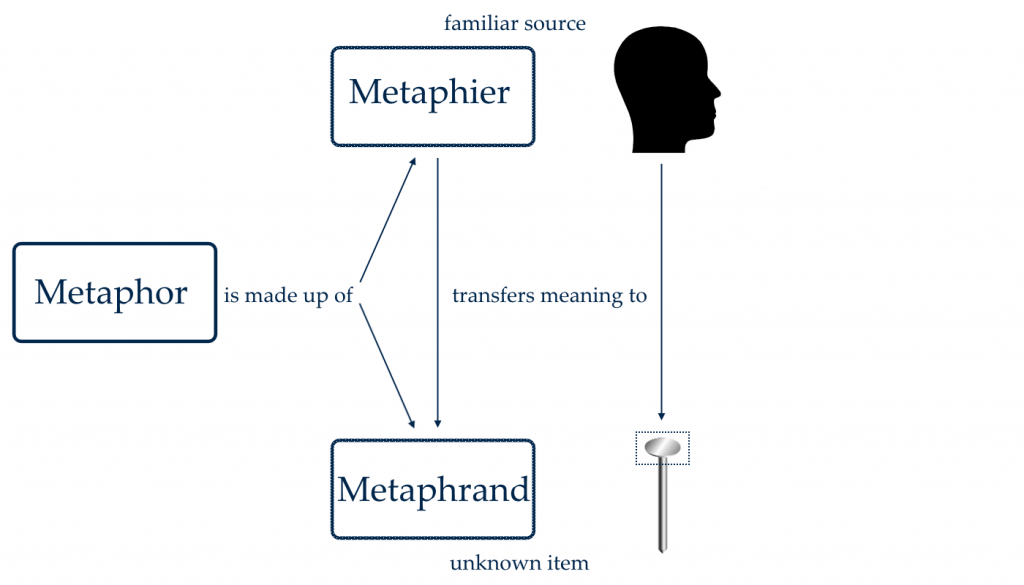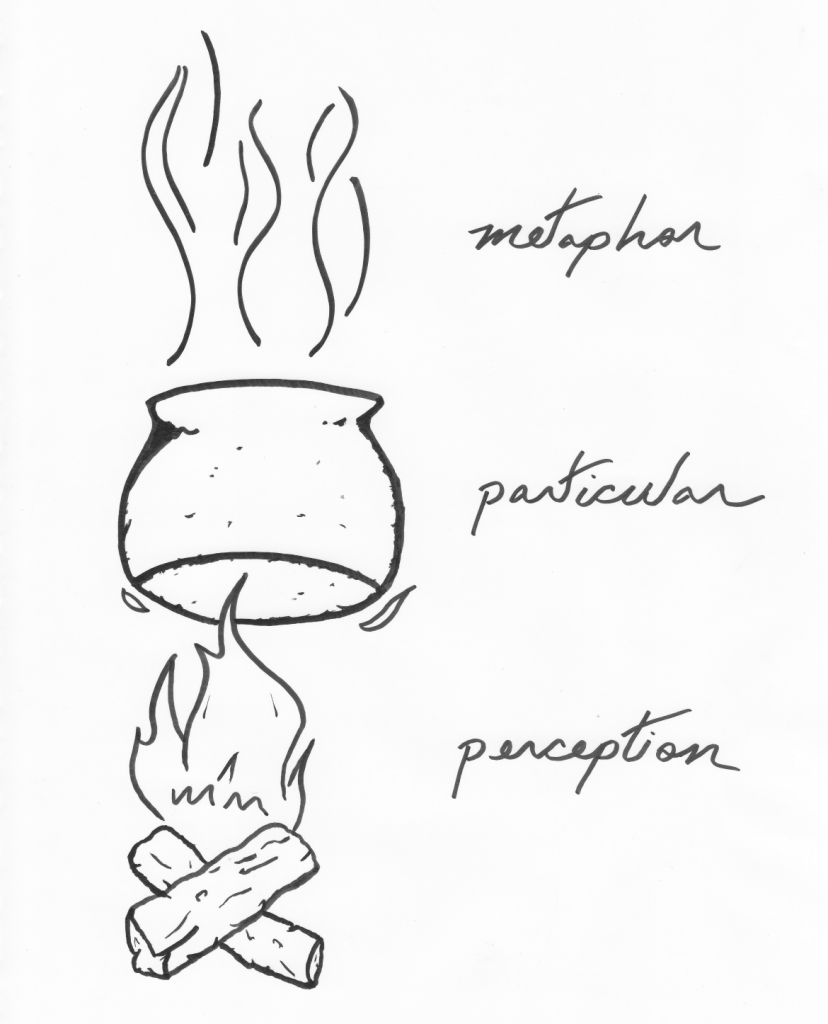The drive toward the formation of metaphors is the fundamental human drive, which one cannot for a single instant dispense with in thought, for one would thereby dispense with man himself.
— Friedrich Nietzsche
Metaphor is the often overlooked and undervalued engine which provides much of the power of language, and it allows for the exponential expansion of our otherwise concrete system of symbols. The word metaphor comes from the Greek word metaphora, meaning “a transfer,” particularly in “the sense of one word to a different word, literally “a carrying over.”[1] Like it’s name suggests, a metaphor transfers the usage of one term, or phrase, to describe something else because of a perceived similarity of the two things, or because of a certain relationship which the objects share. We see the world through the lens of language, the perception of new objects which we encounter is based upon our existing vocabulary– as Julian Jaynes states in The Origin of Consciousness in the Breakdown of the Bicameral Mind, “language is an organ of perception, not simply a means of communication.”(pg 50)[2]
When books were first made available many years ago a person who encountered one may have been perplexed by it, they may have seen someone looking at words on a page and thought “a box made out of tablets.” Then when they saw how easily the person flipped to the next page they may have thought, “it’s a tree made out of leaves of words!” Interestingly enough, the word book comes from the Proto-Germanic word meaning “beech … the notion being of beechwood tablets on which runes were inscribed, but it may be from the tree itself.” [3] Many of the metaphors we use today are considered dead metaphors, meaning that they were used so often that the imagery associated with them is essentially lost (a good example of this would be “iron resolution”)– oftentimes this occurred so long ago that most people don’t even realize that imagery was once connected to it. This quote from Jaynes provides two excellent examples of words which were at one time metaphors:
Even such an unmetaphorical-sounding word as the verb ‘to be’ was generated from a metaphor. It comes from the Sanskrit bhu, “to grow, or make grow,” while the English forms ‘am’ and ‘is’ have evolved from the same root as the Sanskrit asmi, “to breathe.” It is something of a lovely surprise that the irregular conjugation of our most nondescript verb is thus a record of a time when man had no independent word for ‘existence’ and could only say that something ‘grows’ or that it “breathes.” Of course we are not conscious that the concept of being is thus generated from a metaphor about growing and breathing. Abstract words are ancient coins whose concrete images in the busy give-and-take of talk have worn away with use. (pg 51)[2]
At the most basic level, how exactly does metaphor operate? A metaphor is made up of two parts, the metaphier and the metaphrand*– the metaphrand is the unknown/unlabeled object which needs illumination, and the metaphier is the familiar source which provides this.[See Figure 1] In a sense, the metaphier is an iron statue in the mind, while the metaphrand is an unknown ore, in order to try to try to understand what the metaphrand is it must be melted down by the senses into it’s constituent forms which can then be poured into the mold of an existing statue. Anytime you melt down ore there will always be slag, or glass-like byproducts which are discarded, but this is the nature of perception– something is always lost when a thing changes from one form to another. A similar reaction occurs when a person attempts to hand an iron statue to another, the entire statue can’t be handed over, so instead the parts of the statue are described in a way that leads the other person to craft a similar sculpture in their own mind. With art, especially visual art, the artist is able to put down on paper (or whatever medium) what otherwise would be a fleeting idea or image and in doing so others may get a glimpse of the mysterious workings of another person’s mind.
Analogs are also an important part of cognition, they are a type of model which is generated directly from it’s source on a point by point basis as is the case with a map. Jaynes describes maps, and analogs, in this way:
It [a map] is not a model in the scientific sense, not a hypothetical model like the Bohr atom to explain something unknown. Instead, it is constructed from something well known, if not completely known. Each region of a district of land is allotted a corresponding region on the map, though the materials of land and map are absolutely different and a large proportion of the features of the land have to be left out. And the relation between an analog map and its land is a metaphor. (pg 54)[2]
Analogs allow us to share, and preserve, knowledge in a visual way so that it’s easy to understand, in a sense they could be considered a universal language. Like metaphors, analogs simplify something which would otherwise be too complex to understand or communicate.
Subjective conscious mind is an analog of what is called the real world. It is built up with a vocabulary or lexical field whose terms are all metaphors or analogs of behavior in the physical world. Its reality is of the same order as mathematics. It allows us to shortcut behavioral processes and arrive at more adequate decisions. Like mathematics, it is an operator rather than a thing or repository. And it is intimately bound up with volition and decision. (pg 55)[2]
Metaphors are essentially the building blocks of the mind, and analog is the place where architecture occurs. By manipulating these building blocks into countless different positions and patterns we’re able to quickly think out what would happen if we were to commit to any particular action thus we are able to project possible future outcomes before deciding which one would be the most beneficial. An important, related part of consciousness is what Jaynes referred to as the “analog I,” this is essentially the metaphor that we have of ourselves– Jaynes describes this mental feature in the following section:
[Consciousness] operates by way of analogy, by way of constructing an analog space with an analog ‘I’ that can observe that space, and move metaphorically in it. It operates on any reactivity, excerpts relevant aspects, narratizes and conciliates them together in a metaphorical space where such meanings can be manipulated like things in space. Conscious mind is a spatial analog of the world and mental acts are analogs of bodily acts. Consciousness operates only on objectively observable things. Or, to say it another way with echoes of John Locke, there is nothing in consciousness that is not an analog of something that was in behavior first. (pg 65-66)[2]
In a universe which is infinitely large, metaphor is a net which allows us to catch otherwise fleeting details and label them so that they can be perceived, spoken about, and recalled. It is this process of labeling that allows us to simplify and then examine the world around us; the forms/particulars which we see are concrete/solid, so they must be distilled before they can fully enter our conscious mind.[See Figure 2] Since we see the world through the lens of language, and metaphor allows for the infinite expansion of our limited set of symbols, it goes to follow that metaphor allows for the expansion of our mind in a similar way. As cognition, and perception, are based on language there would be a natural limit on them if not for the expansive power of metaphor which carries meaning from one subject to another.
We believe that we know something about the things themselves when we speak of trees, colors, snow, and flowers; and yet we possess nothing but metaphors for things– metaphors which correspond in no way to the original entities.
— Friedrich Nietzsche
* These are the two parts of a metaphor with the words coined by Jaynes (the terms were based on multiplication wherein a multiplier operates on a multiplicand), there are other similar terms which were created by other writers but they had a slightly different connotation– the most commonly used terms today seem to be “tenor” and “vehicle” which were created by I. A. Richards.
[1] Online Etymology Dictionary, metaphor: http://www.etymonline.com/index.php?term=metaphor&allowed_in_frame=0
[2] Jaynes, J. (1976). The Origin of Consciousness in the Breakdown of the Bicameral Mind. Boston: Houghton Mifflin.
[3] Online Etymology Dictionary, book: http://www.etymonline.com/index.php?term=book&allowed_in_frame=0

